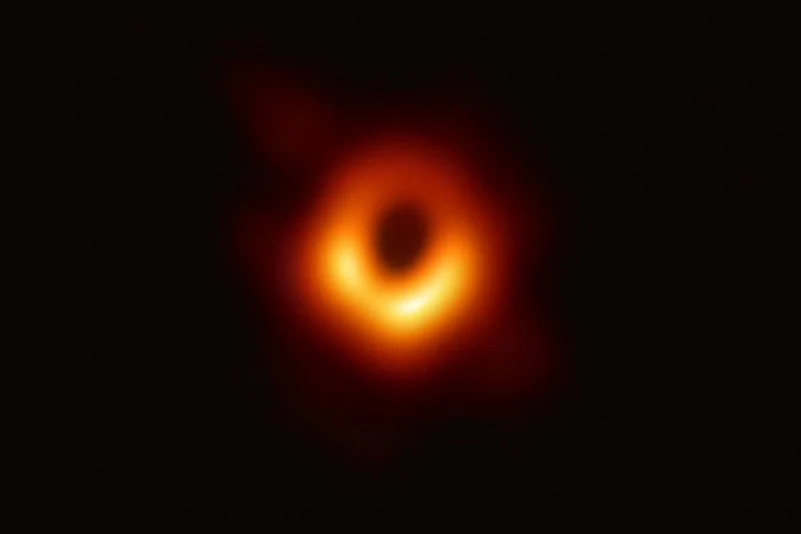Scientists on Thursday unveiled the most detailed and highest resolution simulation of a black hole to date, solving a 40-year-old mystery about the nature of accretion disks- a matter that orbits and eventually falls into the star-devouring body.
The research, published in the journal Monthly Notices of the Royal Astronomical Society, found that the inner-most region of an accretion disk aligns with its black hole's equator.
The finding solves a longstanding mystery, originally presented by Nobel Prize-winning physicist, John Bardeen, and astrophysicist, Jacobus Petterson in 1975.
At the time, Bardeen and Petterson argued that a spinning black hole would cause the inner region of a tilted accretion disk to align with its equatorial plane.
After a decades-long, global race to find the so-called Bardeen-Petterson effect, the team's simulation found that, whereas the outer region of an accretion disk remains tilted, the disk's inner region aligns with the black hole.
A smooth warp connects the inner and outer regions. The team solved the mystery by thinning the accretion disk to an unprecedented degree, and including the magnetized turbulence that causes the disk to accrete.
Previous simulations made a substantial simplification by merely approximating the effects of the turbulence.
"This groundbreaking discovery of Bardeen-Petterson alignment brings closure to a problem that has haunted the astrophysics community for more than four decades," said Alexander Tchekhovskoy, an assistant professor at Northwestern University in the US.
"These details around the black hole may seem small, but they enormously impact what happens in the galaxy as a whole. They control how fast the black holes spin and, as a result, what effect black holes have on their entire galaxies," said Tchekhovskoy.
"These simulations not only solve a 40-year-old problem, but they have demonstrated that, contrary to typical thinking, it is possible to simulate the most luminous accretion disks in full general relativity," said Matthew Liska, from the University of Amsterdam in the Netherlands.
"This paves the way for a next generation of simulations, which I hope will solve even more important problems surrounding luminous accretion disks," Liska said.
Nearly everything researchers know about black holes has been learned by studying accretion disks.
Without the intensely bright ring of gas, dust and other stellar debris that swirls around black holes, astronomers would not be able to spot a black hole in order to study it.
Accretion disks also control a black hole's growth and rotation speed, so understanding the nature of accretion disks is key to understanding how black holes evolve and function.
"Alignment affects how accretion disks torque their black holes," Tchekhovskoy said.
"So it affects how a black hole's spin evolves over time and launches outflows that impact the evolution of their host galaxies," he said.
Until present day, simulations have been too simplified to find the storied alignment. Two main issues have acted as a barrier for computational astrophysicists.
For one, accretion disks come so close to the black hole that they move through warped space-time, which rushes into the black hole at immense speed.
Complicating matters further, the black hole's rotation forces space-time to spin around it.
Properly accounting for both of these crucial effects requires general relativity, Albert Einstein's theory that predicts how objects affect the geometry of space-time around them.
Second, astrophysicists have not had the computing power to account for magnetic turbulence, or the stirring inside of the accretion disk.
This stirring is what causes the disk's particles to hold together in a circular shape, and what causes gas eventually to fall into the black hole.
Without being able to resolve these features, computational scientists were unable to simulate realistic black holes.
To develop a code capable of carrying out simulations of titled accretion disks around black holes, researchers used graphical processing units (GPUs), instead of central processing units (CPUs).
Extremely efficient at manipulating computer graphics and image processing, GPUs accelerate the creation of images on a display.
They are much more efficient than CPUs for computing algorithms that process large swaths of data.
The GPUs substantially accelerated the simulation, and the adaptive mesh increased resolution.
These improvements allowed the team to simulate the thinnest accretion disk to date, with a height-to-radius ratio of 0.03.
When the disk was simulated this thin, the researchers could see alignment occur right next to the black hole.
"The thinnest disks simulated before had a height-to-radius ratio of 0.05, and it turns out that all of the interesting things happen at 0.03," Tchekhovskoy said.
(PTI)















